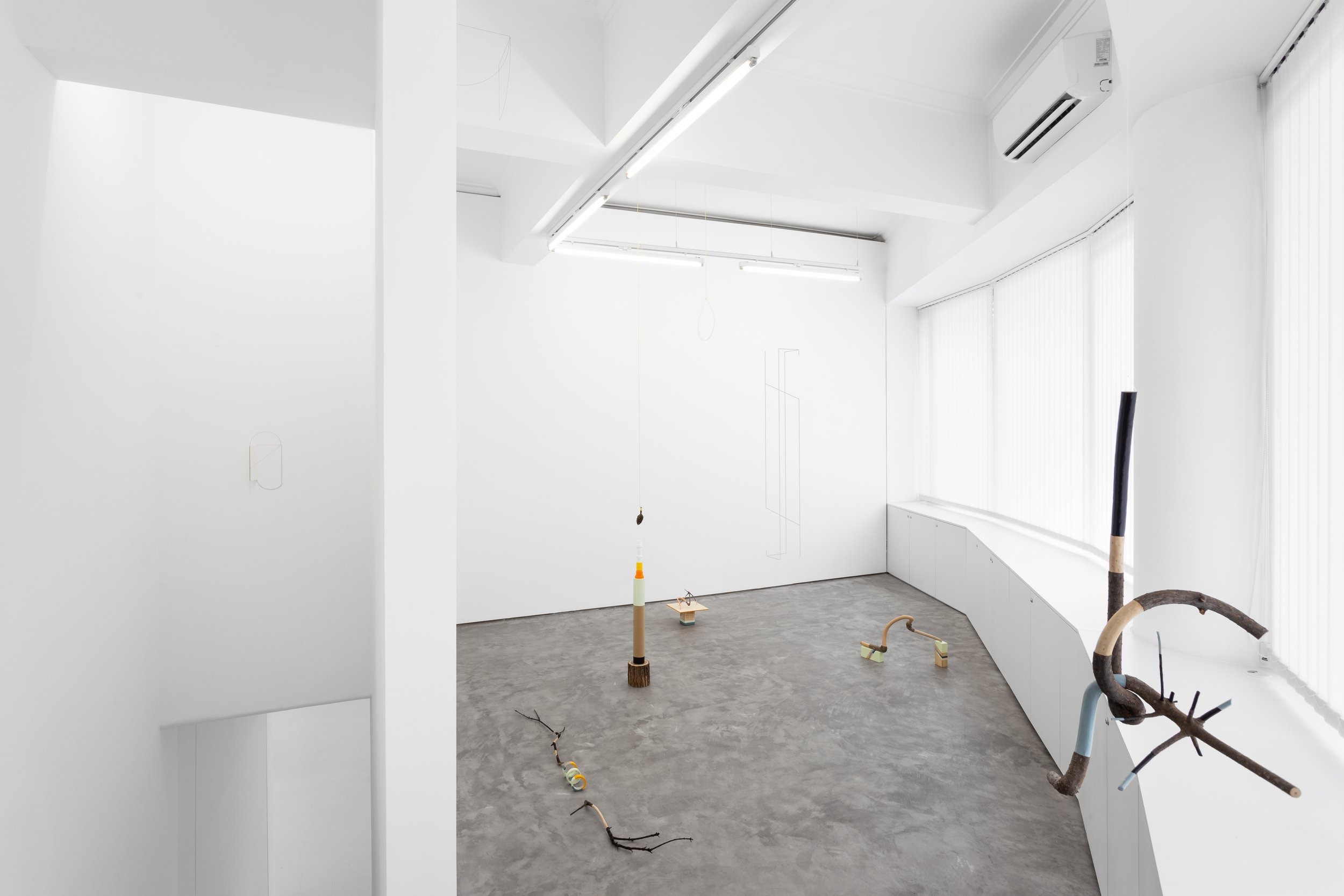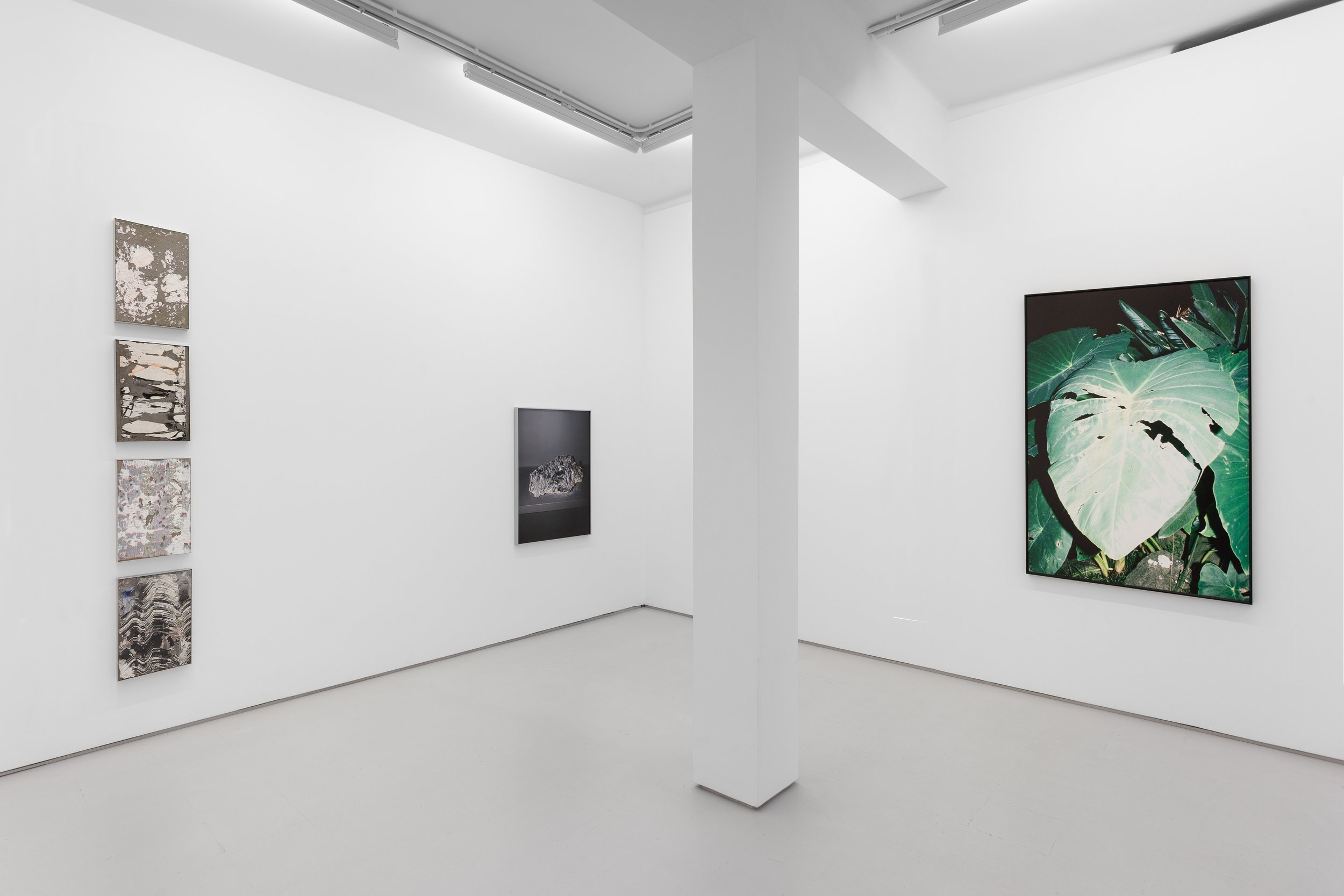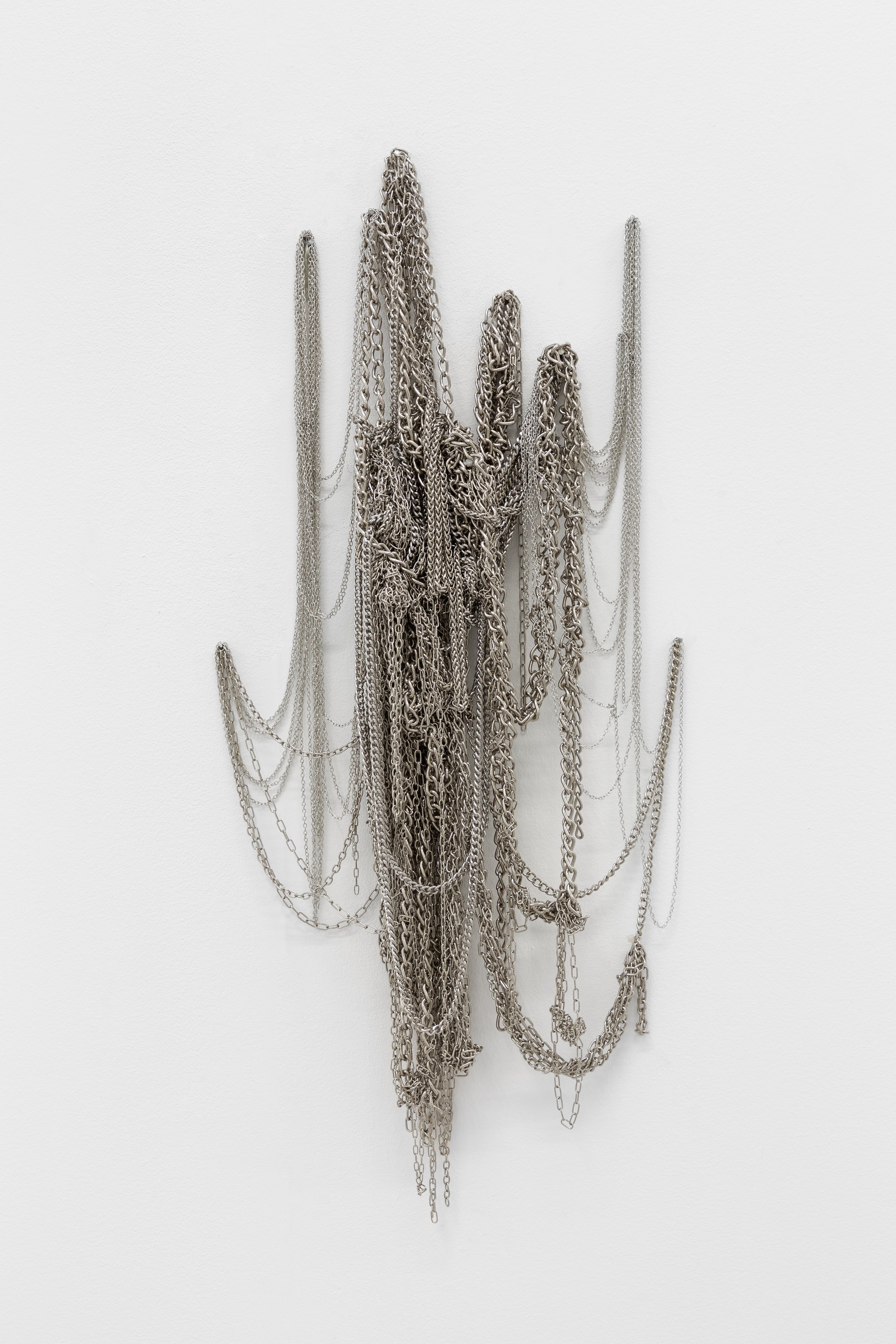
Matter-Affect

Matter-Affect was a group show with works by Daniela Ângelo, Jong Oh, Keke Vilabelda, Nora Aurrekoetxea and Pilar Mackenna, curated by me for NO·NO Gallery, in Lisbon. The show was on view from the 8th of June until the 29th of July of 2022.
Image credits: Exhibition view, Bruno LopeS. Courtesy of the photographer and NO No gallery.
Sometimes it is necessary to pause. To carelessly contemplate what surrounds us so that amazement can arise and take care of us. In the context of contemporary art, this can imply going against the stream or resuming and exploring forgotten, dormant paths, which are not part of the “grand narratives” (the grand narratives which have failed alongside modernism, which are being replaced by other narratives, which were born from the flaws of the first, and which are however increasingly tending towards homogenisation and saturation that nullify the differences they claimed at the beginning), not subjected to the Zeitgeist, which constitute themselves as other ways of experimentation. These often come from a force which we could call interior, although in it are implicated forces that gravitate towards an exterior of shapeless, permeable, and tumultuous contours, such as those that define our present. Sometimes it is also necessary to destroy the very notion of the present and reinscribe ourselves in cyclical time, in the time of the eternal return, in the virtual past, as Bergson dictated time, even if it is already unanimously accepted that our time has long ceased to be the linear teleologic vision of human progress, to be understood from multi-directional perspectives, as Braidotti has been defending.
In the foreground - this utopian plane - the aim was to think about the matter-affect relationship, appropriating the theory of individuation and the modulation principle of Gilbert Simondon, considering that there is a transformation of the material (any material: rocks, steel, plaster, pigments, light, objets trouvés, branches, among many others), as it is in its raw or found state (which may presuppose the existence of previous transformations, resulting from the action of time or the elements of nature on the material, etc.) in an expressive matter, understood as a component of the work of art, intrinsic and irreducible to its composition. Implicit is double transduction between the material and its transformation into an expressive matter in the face of the reaction to other components and between the material and the artist, which preferably occurs on a plane where all the components are understood (or rather felt) like forces. The energetic exchange, that flows between the artist and the material, is not linear (and often occurs in a moment of abandonment of consciousness, leading the artist to unpredictable experimentation). It is intensified by the experience of the present moment in which the limits of affects are questioned (this is still the main way in which we know the world - the way we are affected by phenomena). Both the artist and the inert material (before its transformation into an expressive matter) are intertwined in this incessant exchange (which is no longer, however, the classic struggle between artist and material, instruments or techniques, although all these can concentrate and release forces which act on the final composition plane of the artwork).

Exhibition view of the gallery’s ground floor featuring works by Jong Oh and Pilar Mackenna. Photo: Bruno Lopes.
In Gilbert Simondon’s modulation model (opposite to the traditional hylomorphic model), there is no separation between form and matter. On the contrary, both form and are formed simultaneously and continuously on the plane of forces generated between them. For Simondon, the brick does not result from the imposition of a form onto an inert material but rather from the particular qualities and the potential of clay that give it a moldable structure. It is this potential for deformation and variation within the clay that allows its transformation, while the cast, which determines the shape, is a contour that delimits and conditions these potentialities through the forces that it radiates. Individuation is not a model of casting, but rather of modulation (and Simondon insists on this distinction) insofar as the first is static and the second is a continuous dynamic process. Considering Simondon‘s theory of individuation, the pre-individual potentialities of clay undergo particular individuation, whose limits are determined by the cast. This theory necessarily becomes more complex when we move onto all domains of individuation, because both form and matter activate, in addition to those of substances, very different forces, some of which result from external power relations... And this leads us to immediately leave the predefined utopian plane, with a caveat, however: we will continue on a plane where form and matter form an indecomposable block and are mutually composed.
Matter concentrates, in itself, affects (they are not external to it, nor imputed). Affect is understood as a sensitive compound released by the individuation process of matter (and not as belonging to a subject) that results in its capacity to create different states such as attraction, empathy, horror and repulsion (among others) independent of subjective emotion. Returning to Simondon‘s model of modulation, we think of the different powers of matter, which are in constant becoming, as intrinsic affects to matter (taking into account that it results from a double process of individuation, as defined).

Exhibition view of the gallery’s underground floor featuring works by Daniela Ângelo and Nora Aurrekoetxea. Photo: Bruno Lopes.
The selected works by Keke Vilabelda, Daniela Ângelo, Nora Aurrekoetxea, Jong Oh and Pilar Mackenna explore, in very different ways, this relation between matter and affect, starting from experimentation on materials, on the substances of which they are composed, and on the forces they concentrate, which find in the transformation to an expressive matter a distinct composition, drawing a new energetic field (or immanent vibration) released by gestures, lines and colours. This energetic field intensifies by the encounter between different works, producing different reverberations and resonances, which increase whenever we place ourselves at the intersection of opposing forces (such as, for instance, between the force of gravity and suspension, between weight and lightness) or between forces that act by continuity (between materials that are in the same chain of transformation such as, for example, the mineral). Simultaneously, the resonances which arise between forms in some of these encounters send the forces back to matter, in this sense that both form and matter build each other up.

Exhibition view of the gallery’s underground floor featuring works by Daniela Ângelo and Keke Vilabelda. Photo: Bruno Lopes.
In Keke Vilabelda’s work, we find the affect that is also the memory that matter preserves (always the memory that unfolds in two, the one that remains virtual and the one that updates itself) which reveals time and defies death. The paintings on display result from a manipulation of the different forces at work in painting: forces of speed, evaporation, rarefaction, erosion, and crystallisation of coloured pigments. The greatest force will be that of time itself that paintings liberate, from the layers revealed to the ambiguous areas where we lose our gaze and become attentive. They are mineral-paintings.

Keke Vilabelda’s mineral-paintings together with a photograph by Daniela Ângelo. Photo: Bruno Lopes.
Photography has another materiality, but like Vilabelda’s mineral-paintings, it also expresses the force of time. Time in a photograph is always past. Daniela Ângelo accentuates this time even more, capturing objects and beings devoid of organic life but which hold another life, born from matter and its affects, especially through the manipulation of one of the other materials of photography: light. An intense light that reverberates in space, bringing those beings and objects from death. And with them, desire and passion.

Exhibition view of the gallery’s underground floor featuring a photograph by Daniela Ângelo together with Nora Aurrekoetxea’s sculptures. Photo: Bruno Lopes.
Nora Aurrekoetxea’s sculptures directly refer to the affects of an absent body, which the artwork does not represent, but potently contains. It is itself an affective body, creating an indiscernibility between sculpture-body-affect, presenting complex degrees or stages of fragmentation, tension, protection, vanity, fluidity, and lightness, among others, composed by the works' matters, namely through the always open individuation process in the confrontation with the spectators‘ bodies. Lines become gestures, sometimes more violent, other times slender and aerial. Volumes and the material processes that conceive them become members of bodies. Heavy bodies, romantic bodies, bodies that carry their own fatality, their destiny.

Nora Aurrekoetxea’s sculpture Kateak, 2022 (assembled on site). Photo: Bruno Lopes.
Lines become gestures and movements, too, in Jong Oh's sculptures and sculpture-drawings. Besides the interchangeability of expressive qualities and materials between the fields of sculpture and drawing, the works on display relate to architectural archetypes - such as the column and the arch - that maintain a direct connection to the body, using elementary forces such as gravity, weight and suspension, and volatile and floating materials such as light and shadow. The artist himself explains that his line sculptures, for example, result from a dialogue between himself and space. We immediately think of space as a resonance box, traversed by lines, air masses, light and shadow, which are crystallised in Jong Oh's sculptures, revealing the affects of space itself. Particularly in the folding drawings, we witness a kind of dance in which the lines (of the drawing) intertwine, move away, and detach themselves from the planes (of the sculpture) and vice-versa, also taking us back to the invisible affects or forces of space. And although we are looking at a drawing-sculpture, it puts the space around us in motion and our body in space-motion, twist, fold, mirror, illusion of itself.

Jong Oh’s Line sculpture (column) #11, 2022. Photo: Bruno Lopes.
Pilar Mackenna understands the relationships with different materials (both natural and industrial) as part of a great ecosystem, where the connections between human beings, nature, animals, and objects are inscribed. Her practice evolves from experimentation and manipulation of materials, encompassing both knowledge of their physical and constructive properties and intuitive processes of association and transformation, in which both are constituted as ways of scrutinizing and understanding the Other. For this exhibition, the artist retrieves sculptures conceived from pieces of trunks and branches collected in Chile (her homeland), whose found forms resulted from animal interventions (such as the Chilean wood fly that creates twists in the branches) or from the action of violent forces (such as forest fires), in which she delicately intervenes, in a precise and intense listening to the form-matter found. To this set of sculptures, which carries with it the geography of an affective place (but whose artistic action allows to extract the affects from the affections, as Deleuze would say), the artist adds new sculptures, conceived from materials and objects found in the city of Porto, where she currently lives. Her installation expresses this vitalism inherent to matter, reaffirming that, as complex and heterogeneous as it is, it is the matter that constructs everything, that connects everything, finally unleashing in each person their own affects (including empathy).
Let us, too, decide what we want to take into ourselves from the present.

Pilar Mackenna’s sculpture Crust, Mantle, Core Series / 3, 2019. Photo: Bruno Lopes.